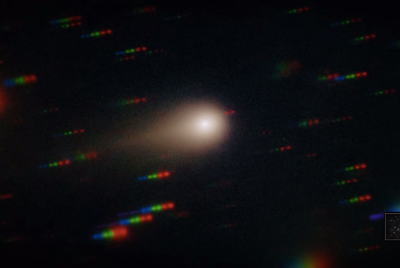Other' Comet ATLAS Now A 'Cloud Of Debris' Nearing Earth On 25 November
New observations confirm the object shattered under gravitational strain

The night sky often holds surprises, but few are as dramatic as the fate of a comet. Comet ATLAS, once anticipated as a spectacular celestial visitor, has instead undergone a spectacular demise.
Initially tracked as a promising sight, the object is now confirmed to have disintegrated into a vast cloud of space dust and fragments. This diffuse cosmic remnant is still hurtling towards our planet, scheduled for its closest approach to Earth on 25 November.
Comet Break-up Confirmed
Recent observations have confirmed that the 'other' Comet ATLAS has broken into pieces, scattering its remnants as a large, expanding cloud of material into space.
Astronomers with the Asteroid Terrestrial-impact Last Alert System (ATLAS) first discovered this object, named C/2025 K1 (ATLAS), in May; it passed its perihelion — its closest distance to the Sun — on 8 October.
🚨 K1 ATLAS Just Broke Apart — A Once-in-a-Lifetime Cosmic Event You Can’t Miss 💥
— Astronomy Vibes (@AstronomyVibes) November 14, 2025
On 13 November 2025, astronomers captured something rare and amazing: Comet C/2025 K1 ATLAS has broken into pieces. At first, it looked like a huge cosmic explosion. But this is not the famous… pic.twitter.com/Q6ll8YTf2w
Despite the similar timing of their discoveries by the same telescope network, this comet is unrelated to the popular interstellar comet known as 3I/ATLAS.
READ MORE: 3I/ATLAS Survived Perihelion as Single Body — Harvard's Loeb Questions Its Origin
READ MORE: 3I/ATLAS: Harvard's Loeb Urges NASA To Release 40-Day-Old HiRISE Images Amid Global Intrigue
Initial Survival Signals
The first observations initially suggested that Comet K1 had completed its solar orbit, passing the Sun at its nearest point, 31 million miles (50 million kilometres). For reference, this was roughly four times closer than the minimum distance achieved by Comet 3I/ATLAS.
Interstellar Comet 3I/ATLAS is fragmenting on its way back out from the Sun. https://t.co/m6ifXK5zaY pic.twitter.com/i7s9QQyRem
— Corey S. Powell (@coreyspowell) November 13, 2025
New observations by astronomer Gianluca Masi in Manciano, Italy, reveal a different story. The Sun's gravitational pull was too powerful for the comet to handle, resulting in its fragmentation into several distinct pieces or clouds of material.
Witnessing the Debris
'Several parts (sub-nuclei or clouds of debris) are visible, also a plume just below the leading (the first from the left) fragment', wrote Masi, an astronomer based at the Astronomical Observatory of Campo Catino and founder of The Virtual Telescope Project, in a recent update.
For those curious, here I found an image of 3I/ATLAS and its tail, taken by Gianluca Masihttps://t.co/fOafpGQCL8 pic.twitter.com/wmtnc0cETu
— Gaany Cano (@CanoGaany) November 12, 2025
The process of C/2025 K1's disintegration was actually heralded by a sudden increase in brightness right around perihelion. During this event, the object shifted its appearance from the greenish shade common to comets near the Sun (a colour generated by fluorescing diatomic carbon) into a brilliant, golden stream.
The origin of this transformation is yet to be determined. One hypothesis suggests the colour change was connected to a relatively low concentration of carbon-containing molecules within the comet's coma — the cloud of ice, gas, and dust around the central body.
READ MORE: Avi Loeb Calculates 3I/ATLAS is One in 100 Million Chance of Being Natural
READ MORE: 3I/ATLAS Loses Comet-Like Tail and Gains Rounded Form — Experts Urge Careful Analysis
Where to Spot the Cloud
To see the remnants of the exploded comet, search in the constellation Leo, where it is visible at a magnitude of 9.9, as reported by The Sky Live. (For context, a lower magnitude denotes greater brightness in astronomy; Regulus, the main star in Leo, measures about 1.35 on the apparent magnitude scale.)
Although the comet is currently too dim to be viewed with the unaided eye, it is accessible to anyone with a decent telescope or a pair of celestial binoculars.
Whatever pieces of the comet remain are scheduled to pass closest to our planet on 25 November. This will happen at a distance of approximately 37 million miles (60 million km) — just under half the mean separation between the Earth and the Sun.
A Final Spectacle
The ultimate fate of Comet ATLAS serves as a dramatic reminder of the forces at play in our Solar System. While its close flyby on 25 November will not bring a brilliant comet, this passing cloud of debris offers sky-watchers a unique, albeit subtle, celestial spectacle before it finally disappears from view.
© Copyright IBTimes 2025. All rights reserved.





















